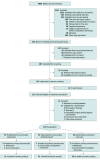Combining Exercise Training and Testosterone Therapy in Older Women After Hip Fracture: The STEP-HI Randomized Clinical Trial
- PMID: 40372752
- PMCID: PMC12082367
- DOI: 10.1001/jamanetworkopen.2025.10512
Combining Exercise Training and Testosterone Therapy in Older Women After Hip Fracture: The STEP-HI Randomized Clinical Trial
Erratum in
-
Errors in the Author Affiliations.JAMA Netw Open. 2025 Jun 2;8(6):e2519679. doi: 10.1001/jamanetworkopen.2025.19679. JAMA Netw Open. 2025. PMID: 40549390 Free PMC article. No abstract available.
Abstract
Importance: Despite receiving postacute rehabilitation services, many older women with a recent hip fracture repair are unable to return to their prefracture level of function. Whether testosterone therapy can enhance recovery after hip fracture in older women with persistent mobility impairments has not been fully examined.
Objective: To evaluate the effects of a supervised exercise program combined with topical testosterone therapy on functional outcomes in older women with a recent hip fracture.
Design, setting, and participants: This phase 3 double-blind, placebo-controlled randomized clinical trial, Starting a Testosterone and Exercise Program After Hip Injury (STEP-HI), was conducted at 8 US sites between December 2018 and August 2023. Participants were women aged 65 years or older with a recent surgical repair of a nonpathologic femur fracture, met objective criteria for mobility impairment, and were community dwelling after discharge from rehabilitation. During the first 14 months of the trial, participants were randomly assigned to 1 of 3 treatment groups: exercise plus topical testosterone gel, exercise plus placebo gel, or enhanced usual care. Statistical analysis, using a modified intention-to-treat approach, was performed from November 2023 to November 2024.
Interventions: For 24 weeks, the 2 exercise groups underwent a supervised, multimodal high-intensity exercise program that included progressive resistance training with trained and certified exercise interventionists. Testosterone was provided in the form of a topical gel (generic 1.0% testosterone), and the placebo gel was chemically identical but without testosterone. The enhanced usual care group was prescribed a self-administered low-intensity home-based exercise program and a staff-led monthly health education session.
Main outcomes and measures: The primary outcome was the between-group difference in the change in the 6-minute walking distance (6MWD) from baseline to 24 weeks.
Results: Among the 129 women randomized (54 to the exercise plus testosterone group, 55 to the exercise plus placebo group, and 20 to the enhanced usual care group; mean [SD] age, 79.3 [8.4] years) included in the STEP-HI trial (122 (94.6%) provided primary outcome data for baseline and at least 1 time point (12 or 24 weeks). The mean (SD) change in the 6MWD between baseline and 24 weeks was not significantly different for exercise plus topical testosterone gel (n = 53; 42.7 [8.2] m) compared with exercise plus placebo gel (n = 51; 40.5 [8.4] m) and enhanced usual care (n = 18; 37.7 [14.8] m).
Conclusions and relevance: In the STEP-HI randomized clinical trial, supervised exercise training combined with testosterone therapy conducted in older women recovering from a hip fracture did not lead to significant improvement in 6MWD compared with supervised exercise alone. Adding testosterone therapy to exercise may not provide further benefits for long-distance mobility. Whether it can improve physical performance and mobility for short distances in this patient population warrants further study.
Trial registration: ClinicalTrials.gov Identifier: NCT02938923.
Conflict of interest statement
Figures
References
Publication types
MeSH terms
Substances
Associated data
Grants and funding
LinkOut - more resources
Full Text Sources
Medical
Miscellaneous



